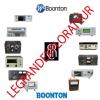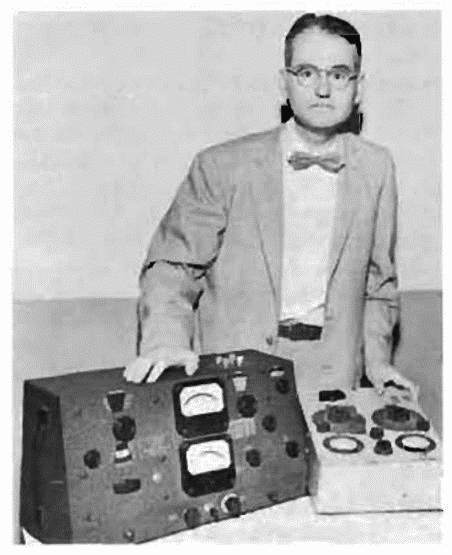
Informazioni sul produttore
Boonton Radio Corp.; Boonton, NJ
In entrambi i casi verrà visualizzato il tuo nome - dopo che un amministratore abbia accettato i tuoi contributi - e saranno visualizzati sotto «Ulteriori particolari...» o nel forum nel caso di testi.
| Nome: | Boonton Radio Corp.; Boonton, NJ (USA) |
| Abbreviazione: | boonton |
| Prodotti: | Modelli Brand |
| Riassunto: |
Boonton Radio Corp. Purchased by Hewlett-Packard in 1959 as a wholly-owned subsidiary, and became a full division in 1962. Note that the earlier (circa 1924) Boonton Radio Corp., mentioned in the closely related Boonton Ruber Mfg. Co., was established by different founders and manufactured a few known radio related products. See Boonton Rubber Mfg. Co. for a expanded history of these three companies. |
| Fondata: | 1934 |
| Chiusa: | 1959 |
| Storia: |
It was in the tiny molding department of the Loando Hard Rubber Co. (1891), renamed the Boonton Rubber Mfg Co. (1911), that Boonton's world-renowned electronic industries began. William D. Loughlin (1893-1950) held the office of president of Radio Frequency Laboratories (1922) from 1930-1934. He left the company and established his own company, this second Boonton Radio Corp. (1934) which specialized in test equipment. Sometime after they were purchased by Hewlett-Packard in 1959, they also started using the name Boonton Radio Corporation. as seen in their Precision Test Equipment 1963-64 Catalog. sources: -- Boonton New Jersey and its role in the Electronic Precision Instruments Industry, reprinted from The Citizen of Morris County Mid-Century Edition, 30 June 1950, thru the courtesy of Ballantine Laboratories. |
Ulteriori particolari per questo produttore inviate dai soci:
|
Visite: 2552 Risposte: 1
1959: Boonton Radio Corp. Merged With Hewlett-Packard Co.
|
|
|
Pius Steiner
03.Oct.13 |
1
Boonton Radio Corp. Merged with Hewlett-Packard Co.Boonton Radio Corporation recently became the newest member of the Hewlett-Packard Co. family of Palo Alto, California as a wholly-owned subsidiary and joined other companies operating under similar status including: F.L. Mosely Co., Pasadena, California, makers of strip chart and X-Y recorders; Palo Alto Engineering Co. of Palo Alto, manufacturers of transformers, potentiometers, and other components; and Dymec, Inc. of Palo Alto, now a division of H-P, manufacturers of precision electronic measuring equipment and systems. Announcing the arrangement between the two companies, Dr. George A. Downsbrough, President of BRC, emphasized that BRC would continue to operate as a separate company with no changes in either management or personnel contemplated. He stated that plans for a new plant, which were underway prior to the merger, would be accelerated. These remarks were echoed by Messrs. Hewlett and Packard who visited BRC to personally welcome BRC into the H-P fold. BRC is looking forward to expanding its line and development activities through the use of H-P development of components and close liaison with their development activities. From a humble beginning in 1939, the Hewlett-Packard Co. has grown to be one of the largest manufacturers of electronic test equipment in the world. The company produces more than 300 different instrument types, including oscillators, voltmeters, signal generators, waveform analyzers, microwave and waveguide test instruments, and oscilloscopes. These products are sold to more than 3000 business organizations throughout the world, with the government, through its various agencies, constituting one of the largest single users of H-P equipment. In addition to its expansion in this country, Hewlett-Packard has established subsidiaries in Germany and Switzerland. The Stuttgart, Germany plant is due to begin production of H-P instruments for the Continental market early next year. This plant will be the manufacturing outlet of the company’s wholly-owned Swiss sales organization which was set up last January. Boonton Radio Corporation is proud to be a member of the progressive Hewlett-Packard family and is looking forward to expanding with a fast growing industry.
Source: |
|
Pius Steiner
03.Oct.13 |
2
Looking Back 25 Years With BRC
Boonton Radio Corporation was established in 1934, but the scene was set before that time, just after the end of the First World War. Many of the concepts that made wireless communication possible were discovered before the War, but it was during the War that new ideas were evolved and that considerable practical experience was
These were the conditions under which the Boonton Hard Rubber Company in Boonton, New Jersey established a group for dealing with the new problems. The staff of the newly formed group, including at first just one physicist, produced coil forms and other radio components using insulating material. Later, additional technical people were employed, and the work of general engineering consultation was undertaken. This type of work naturally led to an understanding of basic test equipment
Late in 1934, Mr. William D. Loughlin, who had been President of Radio Frequency Laboratories and who was one of the industry’s pioneers, together with several associates, purchased one of the buildings which had been used by the Boonton Hard Rubber Company for its radio activities, and formed the Boonton Radio Corporation. The new company concentrated its engineering skill toward the development of new measuring equipment sorely needed by the radio industry at that time.
It was this Q measuring problem, in fact, which led to the development of the first Q Meter. Manufacturers were confronted with the costly annoyance of producing coils that would meet all of the requirements when tested at their own plant, only to be rejected because they did not pass inspection at their customers plant. A need for approved standards was evident and this was among the first assignments of the BRC engineers. First Q Meter Introduced
In November of 1934, Boonton Radio Corporation presented at the Institute of Radio Engineers’ Fall meeting in Rochester, New York, a model of the Company’s first Q Meter. This instrument covered the frequency range of 50 kc to 50 mc and was known as the Type 100-A. With this instrument, Q measurements were made simple and rapid. It was also capable of many other valuable laboratory measurements on basic In 1941, a high frequency model (30 to 200 mc) of the Q Meter, known as the Type 170-A ,was introduced. This instrument was followed by the QX Checker (Type 110-A) , similar to the Q Meter but designed specifically for rapid production testing of components with laboratory accuracy. This instrument was very easy to operate and could be handled by unskilled personnel.
Today, a faster, more versatile instrument, the Q Comparator Type 265-A has replaced the QX Checker and the low frequency Q Meter (Type 260-A) and high frequency Q Meter (Type 190-A) are in very broad use. FM and HF Test Equipment
Just before the Second World War, BRC began development work on a frequency-modulated signal generator to meet the demand for test equipment for the new fm communication equipment. A model of this generator was first presented in 1940 at the Institute of Radio Engineers’ meeting in Boston. Several models of these FM Signal Generators, developed by BRC, were used during the war by military and
During the Second World War, BRC provided large quantities of the standard commercial equipment, which had been previously designed for its commercial customers, to the Military Services for use in the War effort. In fulfilling its patriotic duty, the Company prepared a microwave pulse modulated rf signalgenerator for manufacture. A large number of these instruments were produced for the Military Services for use in testing radar systems. This Signal Generator is still used by the At the end of the War the FM Signal Generator was redesigned to permit coverage of a wider frequency range, to include AM as well as fm, and to obtain deviations in frequency which did not vary with carrier frequency. This instrument had very low leakage and a wide selection of accurately calibrated output voltages. It soon became the standard in this field.
|
Fine delle discussioni nel forum sul questo produttore
| Conformità dei dati | Ulteriori informazioni |






